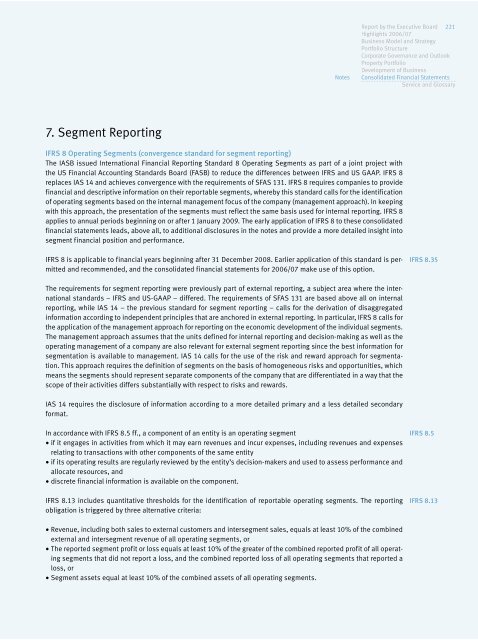IMMOEAST Annual Report 2006/07
IMMOEAST Annual Report 2006/07
IMMOEAST Annual Report 2006/07
Create successful ePaper yourself
Turn your PDF publications into a flip-book with our unique Google optimized e-Paper software.
7. Segment <strong>Report</strong>ing<br />
IFRS 8 Operating Segments (convergence standard for segment reporting)<br />
The IASB issued International Financial <strong>Report</strong>ing Standard 8 Operating Segments as part of a joint project with<br />
the US Financial Accounting Standards Board (FASB) to reduce the differences between IFRS and US GAAP. IFRS 8<br />
replaces IAS 14 and achieves convergence with the requirements of SFAS 131. IFRS 8 requires companies to provide<br />
financial and descriptive information on their reportable segments, whereby this standard calls for the identification<br />
of operating segments based on the internal management focus of the company (management approach). In keeping<br />
with this approach, the presentation of the segments must reflect the same basis used for internal reporting. IFRS 8<br />
applies to annual periods beginning on or after 1 January 2009. The early application of IFRS 8 to these consolidated<br />
financial statements leads, above all, to additional disclosures in the notes and provide a more detailed insight into<br />
segment financial position and performance.<br />
IFRS 8 is applicable to financial years beginning after 31 December 2008. Earlier application of this standard is permitted<br />
and recommended, and the consolidated financial statements for <strong>2006</strong>/<strong>07</strong> make use of this option.<br />
The requirements for segment reporting were previously part of external reporting, a subject area where the international<br />
standards – IFRS and US-GAAP – differed. The requirements of SFAS 131 are based above all on internal<br />
reporting, while IAS 14 – the previous standard for segment reporting – calls for the derivation of disaggregated<br />
information according to independent principles that are anchored in external reporting. In particular, IFRS 8 calls for<br />
the application of the management approach for reporting on the economic development of the individual segments.<br />
The management approach assumes that the units defined for internal reporting and decision-making as well as the<br />
operating management of a company are also relevant for external segment reporting since the best information for<br />
segmentation is available to management. IAS 14 calls for the use of the risk and reward approach for segmentation.<br />
This approach requires the definition of segments on the basis of homogeneous risks and opportunities, which<br />
means the segments should represent separate components of the company that are differentiated in a way that the<br />
scope of their activities differs substantially with respect to risks and rewards.<br />
IAS 14 requires the disclosure of information according to a more detailed primary and a less detailed secondary<br />
format.<br />
In accordance with IFRS 8.5 ff., a component of an entity is an operating segment<br />
• if it engages in activities from which it may earn revenues and incur expenses, including revenues and expenses<br />
relating to transactions with other components of the same entity<br />
• if its operating results are regularly reviewed by the entity’s decision-makers and used to assess performance and<br />
allocate resources, and<br />
• discrete financial information is available on the component.<br />
IFRS 8.13 includes quantitative thresholds for the identification of reportable operating segments. The reporting<br />
obligation is triggered by three alternative criteria:<br />
• Revenue, including both sales to external customers and intersegment sales, equals at least 10% of the combined<br />
external and intersegment revenue of all operating segments, or<br />
• The reported segment profit or loss equals at least 10% of the greater of the combined reported profit of all operating<br />
segments that did not report a loss, and the combined reported loss of all operating segments that reported a<br />
loss, or<br />
• Segment assets equal at least 10% of the combined assets of all operating segments.<br />
Notes<br />
<strong>Report</strong> by the Executive Board 221<br />
Highlights <strong>2006</strong>/<strong>07</strong><br />
Business Model and Strategy<br />
Portfolio Structure<br />
Corporate Governance and Outlook<br />
Property Portfolio<br />
Development of Business<br />
Consolidated Financial Statements<br />
Service and Glossary<br />
IFRS 8.35<br />
IFRS 8.5<br />
IFRS 8.13


